All Saints Anglican Church

All Saints Anglican Church is located on New Ross Road in Leminster. The church was built in 1871 and is remembered as a focal point of the community. The building is a simple wood frame construction with wood shingles. It has Gothic Revival style architecture with slim windows. The bell tower is not symmetrical, which is dissimilar to other churches of the same period in Hants County. It also has an open belfry which is more common among Lunenburg County Churches. The All Saints Anglican Church is valued for its role as a church and focal point in the community of Leminster as well as a good representation of Gothic Revival architecture.
Visit the Canada’s Historic Places page here.
Christ Church Anglican

Christ Church is a fine example of Carpenter Gothic Revival architecture. It also forms one of an interesting trio of buildings designed by Worcester, Mass. architect Stephen C. Earle. The same plans were used to build Trinity Church in Digby, Nova Scotia, and St. Paul’s in Trinity, Newfoundland. Christ Church was built by local contractor Joseph Taylor, using primarily locally harvested woods and hardware manufactured by Windsor Foundry Company.
Clifton House/Haliburton House
Provincial Heritage Designation

Thomas Chandler Haliburton, author, lawyer, politician and judge, was born in Windsor, Hants County, in 1796. The only son of William and Lucy Haliburton, Thomas was a third generation Nova Scotian who is best known for his creation of the infamous Yankee peddler Sam Slick. In fact, Haliburton is generally considered to be the first Canadian author to have gained international recognition and some of his character's more clever sayings, such as "barking up the wrong tree" and "quick as a wink", have survived to find their way into every day twentieth century usage.
In January of 1833, Haliburton purchased a forty acre lot of land located on Ferry Hill over looking the town of Windsor and surrounding area. He named the estate "Clifton" after the home of his wife near Bristol, England, and about 1836 erected a relatively small, one-and-a-half story, wooden Italianate villa on the site.
Clockmaker's Inn
Provincial Heritage Designation
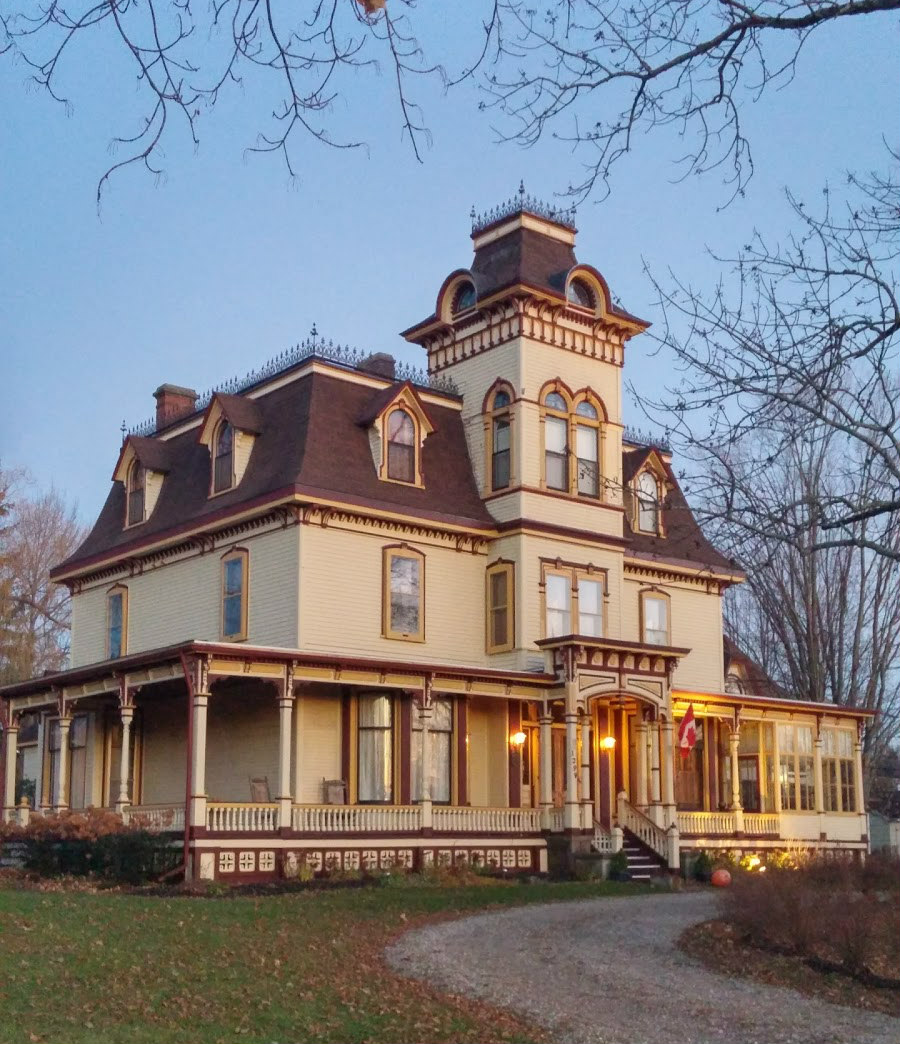
Built by Rufus Curry in 1894. Rufus Curry moved to Windsor in 1888 from Avondale where he and his father built and operated a shipping fleet. He was one of the organizers of Wm. Curry & Sons which was a woodworking factory at Curry's Corner. He also helped in the establishment of the Windsor Electric Light Company. The Currys Corner area of Windsor is supposedly named for him.
The house is an example of the Second Empire style with Queen Anne influences. It is a three storey dwelling of wood construction with a steeply pitched mansard roof with one central projecting tower. It has a symmetrical three bay facade with a centered doorway, numerous dormers with an overhanging gable roof with semi-circular windows and many decorative features.
Convocation Hall
Provincial Heritage Designation
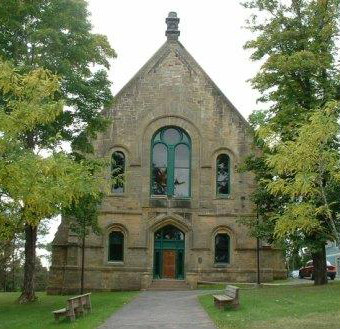
King's College School was founded in 1788 and a year later the province passed an Act establishing King's College. Largely through bequests the college came into possession of a fine library of 18th century books and also through gifts by Thomas Beamish Akins, one of the most important collections of incunabula (books published before 1501) on the North American continent in the 19th century.
In 1858 the Alumni Association of King's College proposed the construction of a convocation hall and library. With the backing of Sir William Fenwick Williams, hero of the siege of Kars in the Crimean War and lieutenant governor of the province, plans proceeded for its construction. The architect chosen was David Sterling and the contractor George Lang. Work began in 1861 and the building was officially opened two years later, but construction problems caused delays and it was not completed until 1867.
Convocation Hall is a large sandstone building, originally constructed as a library between 1861 and 1867, in a Gothic Revival Style. The Gothic Revival detailing of this building is typical of ecclesiastical architecture of the period; largely inspired by medieval English parish churches. These details include: the wall buttresses, the large windows dominating the elevation and the parapet wall emphasizing the profile of the roof peak. An exception to these Gothic rules is the round headed design of the windows, though they are set within slightly pointed architraves.
Dimock House

Dimock House was constructed between 1800-1835 and is located on Highway 236 in Scotch Village. The Dimock family were among the first settlers from New England, originally arriving in 1759. The Dimock House has Cape Cod style architecture, with some Greek Revival exterior details. It is a simple one and one-half (1 ½) storey wood construction with wood shingles. It has a central front door with side lights and two (2) Italianate style bay windows on the front elevation. The land is also included in the Municipal designation.
Visit the Canada’s Historic Places page here.
Greenwood
Municipal Heritage Designation

Greenwood was built in 1830 and is located on Falmouth Dyke Road. It is built on one of the original Falmouth Township land grants for Planter colonists who settled on lands vacated by the 1755 expulsion of the Acadians. This 29-room home is of New England Colonial style architecture. It has five (5) dormers, and a wide verandah covering the front entry doors.
Hantsport Railway Station
Provincial and Federal Heritage Designation

Visit the Canada’s Historic Places page here.
Kempt Shore Presbyterian Church
Municipal Heritage Designation

The Kempt Shore Presbyterian Church was built in 1865 and is located on Highway 215 in Kempt Shore. The church was erected for the congregation of the Presbyterian Church of Scotland. It closed in 1967 for regular services however is still used for weddings and funerals. It is a simple wood frame construction with wood shingles and a steep shingled steeple. It has Gothic Revival windows, and a cemetery surrounds the church. The building, cemetery and land are included in the municipal designation.
Visit the Canada’s Historic Places page here.
Lawson House
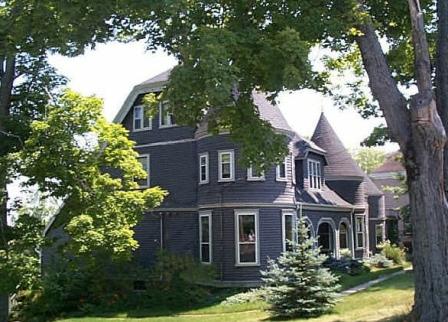
Lawson House, built in 1898 just after the Great Fire, is one of only two buildings in Windsor designed by prominent Maritime architect, William Critchlow Harris. It is of special interest because it is one of the first buildings in which Harris incorporated round towers with conical roofs, a feature which later became a trademark of his work. The house is also significant in Windsor’s history because of its association with former owner H.B. Tremain, Member of Parliament for Hants, and W. Medford Christie, a former Town solicitor.
Old Parish Burying Ground



In 1776, the Honourable Michael Francklin gave about two acres of land for erecting a Church, and for a “Burying Ground”. The Burying Ground was the site of the first two churches in Windsor. The first, which according to Hind was sixty feet square, was built in 1771. Rev. Joseph Bennett, the rector of this chapel appointed in 1775, was buried in the Old Parish Burying Ground in 1795. After the second church was built, this first building was moved opposite the entrance gates to King’s College and Hind reports that formed part of a house.
A second church was built in the Burying Ground between 1788 and 1790. The Church and Burying Ground were consecrated by the Right Reverend John Inglis on November 5, 1826.
According to the survey at the West Hants Historical Society, the oldest surviving gravestone marks the death of Mrs. Rachael Kelley on January 27, 1771. In 1887, the cemetery was closed to burials. Members of some prominent Windsor and Nova Scotian families are buried in the Old Parish Burying Ground including: Isaac DesChamps, the fourth Chief Justice of Nova Scotia (1785-1788), Winckworth Tonge, grandson of one of the original land grantees, and Susanna Francklin, wife of Lieutenant Governor Michael Francklin who donated the land for the Burying Ground, as well as early presidents and professors of King’s College including William Cochran, the first President of the College.
Beyond the genealogical information which may be found in a cemetery, the gravestones tell their own story about attitudes towards death, the business of death and the symbols used by stone carvers to commemorate death. Many of the gravestones are decorated with hands in various positions, urns, cherubs, and other symbols common to gravestone of this period.
Richmond Hill Farm
Provincial Heritage Designation

Richmond Hill Farm is a large 2½ storey, wood frame structure with a truncated gable roof, sitting on a stone foundation.
During its history, the building has been subjected to several additions, all subsequently removed, and alterations. The existing structure demonstrates both early 19th century and late Victorian architectural details. The narrow gable dormer is an example of the former, the front bay windows of the latter. Throughout the house are several suggestions, but no clear evidence, that the structure was built in more than one stage. The best estimate is that the house was erected by Francis Singer sometime in the 1820's.
Saint John the Evangelist Roman Catholic Church
Provincial Heritage Designation

The excavation for this sandstone, Gothic Revival style Church began in 1898 and was completed in 1909. Saint John the Evangelist Roman Catholic Church and glebe house are one of only two buildings in Windsor designed by prominent Maritime architect, William Critchlow Harris. Saint John the Evangelist Roman Catholic Church is valued for its distinctive architecture, which demonstrates architect W.C. Harris' philosophy of both religious and domestic design particularly well.
One of the many buildings destroyed by the Great Windsor Fire of 1897 was the original Roman Catholic Church in Windsor. Monsignor Edmund Kennedy had barely arrived at Windsor to assume the position of parish priest at the time of the fire. Nonetheless, Monsignor Kennedy quickly and with considerable dedication, began the task of rebuilding.
Excavation for the project began on April 6, 1898, with the cornerstone laid August 17 of that year by Archbishop Cornelius O'Brien. Three months later, on November 7, the first Mass was celebrated in the basement of the new structure. Although the new building continued to be used for services, it was not completed until 1909.
St. John the Evangelist Church is unique in the body of Harris' work in that it combines both a church and a residence within one structure. The church is a clear statement in Gothic Revival. Significantly, Harris convinced the parish to build in stone, a material that Harris considered more appropriate for churches. Using Wallace sandstone from northern Nova Scotia, Saint John's incorporates such Gothic Revival elements as wall buttresses, pointed arch window opening, and a much articulated bell tower, with spire. The plan form, with transepts and side aisles, also illustrate this style.
The Glebe House, or residential part of the structure is built of wood, a material more commonly associated with Nova Scotia's domestic structures. Not only its material set this part of the complex apart, however, for here Harris uses a much different style, a variant of the Queen Anne Revival style. Elements of this style, and found in St. John's Glebe, include: the round, squat tower, with steeply pitched conical tower; the broad, shallow arches of the verandah; and the clipped gable of the roof profile.
Even in its siting, the church and glebe are differentiated. The church is adjacent to the street, and looks out to the town; the glebe is to the rear of the structure, and looks out to a more rural aspect. While the combination of functions at St. John's is unique in Harris' work, it is accomplished successfully; and indeed, the resulting work provides a concise expression of his architectural philosophies.
Sainte-Famille Cemetery

The Sainte-Famille Cemetery in Falmouth was designated a Provincial heritage property in September 2017, and a Municipal heritage property in April 2019. The cemetery of approximately 300 graves was uncovered during an archaeological dig in 1996 by the Nova Scotia Museum. The cemetery was used from 1698 until the expulsion of the Acadians in 1755 and is one of the only pre-deportation Acadian cemeteries in Nova Scotia.
Sangster Inn
Provincial Heritage Designation
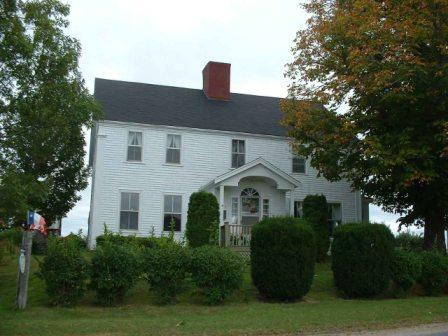
The Sangster Inn, located in Falmouth, was recognized as having Provincial heritage significance in 1991.
In 1800 John Sangster, believed to have come a decade earlier from Scotland, purchased a number of farm lots overlooking the ferry crossing for the road from the Windsor side through to Horton. Later in the same year Sangster received a license to keep a "House of Entertainment for the accommodation of travelers". Whether this house was on the site before Sangster purchased his lots or he had it build is unknown, but the reference is certainly to what became known as Sangster Inn.
The Sangster Inn is a large two and one half storey, wood frame building with a gable roof and large central fireplace. The front elevation is five bays wide with a central entrance, which in turn incorporates an entrance porch, sidelights and fanlight. Besides the entrance the main exterior decorative element is the corner board detailing, with finely moulded capitals. The original windows have been replaced, though the actual window openings remain unaltered. Evident exterior features support a late 18th century date of construction.
Visit the Canada’s Historic Places page here.
Thornton House

Built in 1844 by Thomas Timlin, Thornton is significant in Windsor because of its association with Edward Dimock, who purchased it in 1855. Dimock was a former Mayor and an owner of many major businesses including Dimock’s Hardware (1849), the Windsor Foundry (1855), the Commercial Bank of Windsor (1865), and the Wentworth Gypsum Company (1891). Thornton House is of special interest as it is of Georgian/Federal style, uncommon in Windsor. Many of its original features have been retained and it is probably the oldest brick home in town.
Upper Vaughan Community Hall
Municipal Heritage Designation

Originally known as the South Waterville School, the Upper Vaughan Community Hall was constructed in 1868 as a one-room schoolhouse. This building was constructed to replace the original log schoolhouse in Upper Vaughan. In 1964, the school closed and the building is now used as a community hall.
West Hants Historical Society Museum

It has retained the outward “look” of a church, and thus fits in well as one of five churches along King Street between Water Street and Wiley Avenue. It is a typical example of the Carpenter Gothic vernacular, and is an important part of the overall streetscape. The West Hants Historical Society volunteers play a pivotal role in the preservation of the community’s built and archived heritage, and the museum chronicles the history and culture of Windsor and surrounding area.
Windsor Plains Community Hall
Municipal and Provincial Heritage Designation
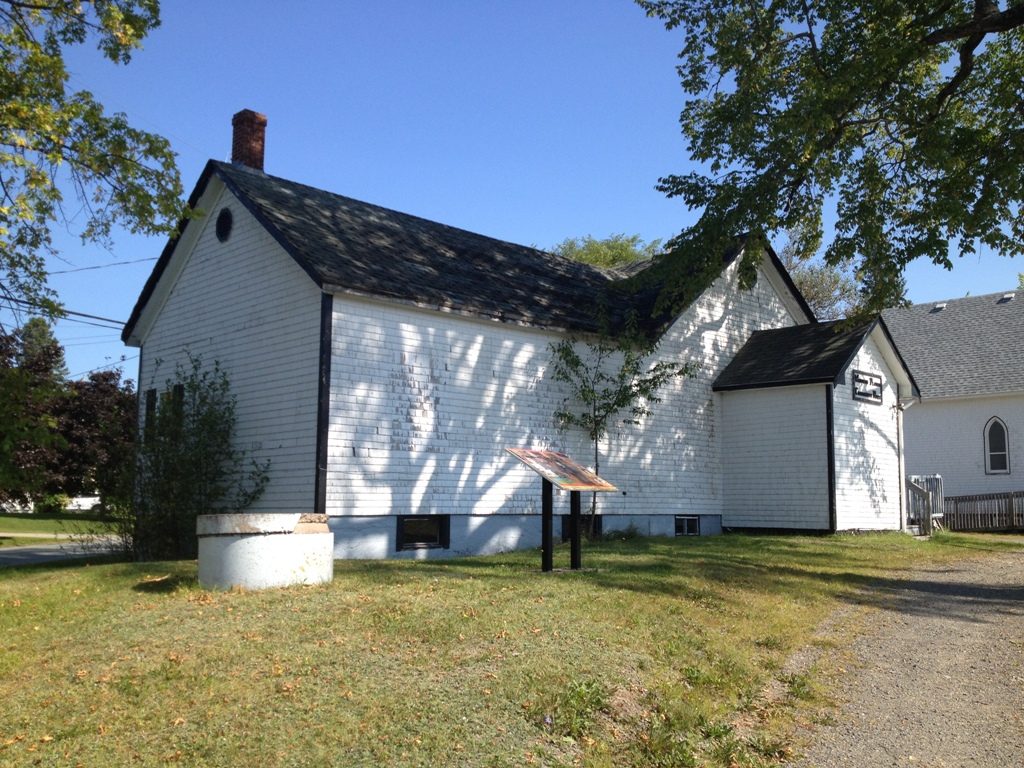
Originally known as the Five Mile Plains School, the Windsor Plains Community Hall is located at the intersection of Pellow Road and Highway 1 in Three Mile Plains. The original date of construction is unknown, however the building was used as a segregated school for black children until 1963. This is one of the last one (1) room segregated school houses remaining in Nova Scotia. It is currently owned by the West Hants African Advisory Association and used as a community hall. It is designated at both the Provincial and Municipal level.
The Manning House
Municipal Heritage Designation

Located in Falmouth, this one-and-a-half storey New England Colonial style home is estimated to have been constructed in 1790-1795, and retains many of its original features and still sits on its original site. Many additions have been made, but they keep with the original style, and do not detract from the historical significance. Described as “a solid conventional type house, a rectangle with a massive centre chimney,” this building is considered a symbol of community importance due to its connection to John Manning and maintaining the rural agricultural character of the area. John Manning is an important community figure. He held the rank of Lieutenant in the Hants County Militia; represented Falmouth in the Legislative Assembly from 1812 to 1818; and was the Chairman of the Town meeting from 1810 to 1852. John Manning built the foundation of stone and mortar, used post and beam construction with 12”-14” beams at a length of 32’ to support the floor, and used handmade brick to build the walls of the home. Although he was not an architect nor builder, this house is well-preserved example of building technology of this time period.

